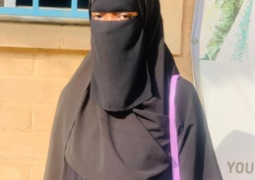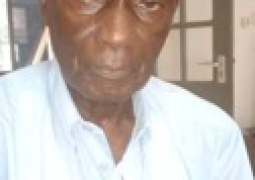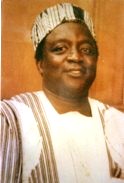
Ebou Dibba (1943 – 2001)
Ebou Dibba completed his university education in Great Britain (University of Cardiff and London) and obtained Bachelor’s and Master’s degrees, with French as a major. Having received his degrees, Ebou Dibba decided to stay in England and work for the education of adults. He was the head of a very much respected school in Surrey for nearly thirty years. In 1993, he was decorated by Queen Elisabeth II with MBE (Member of the British Empire). Ebou Dibba drowned accidentally in December 2000. He published four books.
Olu and the Smugglers - 1980
In 1980, a book entitled Olu and the Smugglers was published by Longman Group UK in the 'Action Books' series. Ebou Dibba, who thus began a literary career - later reinforced by three other novels (Chaff on the wind, 1986; Fafa, 1989; Alhaji, 1992).
The book is designed for young students (Form 3, now Grade 9). It was therefore important that the text was not too long (40 pages), that it included illustrations (nearly thirty), that the story revolved around a young boy (Olu is 13 years old) and that he was the hero of an eventful and exciting story. All this is perfectly at work in Ebou Dibba's text.
The story begins in a small village by the sea. Aunt Abi and Uncle Yancoba, a customs officer, wait for their young nephew Olu. As they have no children, receiving Olu is a real joy. They learn that a story is shaking up the village: many people have become ill from tins of meat, and a lot of empty tins have been found. But nobody has solved the case.
Olu is a nice boy, but he is very imaginative and has a knack for exaggerating everything he sees and does, so little credit is given to what he says. This character trait is not without consequences. One night, Olu and his friend Abu see a boat flashing lights, people coming ashore with packages, and a cyclist leaving; they look like smugglers. The next day, Olu, who cannot make his uncle believe it, finds it urgent to warn the police officer, Sergeant Demfa, whom he meets at the market. Demfa seems interested in Olu's revelation but admits that he could not identify any of the people or know what was in the boxes because of the darkness.
The whole story changes when Abu tells Olu that at the phone box where he was going to call his mother, he overheard a phone conversation between Damfa and someone. The sergeant informed the caller that the boat would have to dock on the beach at one o'clock in the morning because of Olu and Abu's untimely discovery. So Sergeant Demfa was one of the smugglers, probably the cyclist! To get out of this confusing situation, Olu finally convinces his uncle, not without difficulty, that something must be done. Uncle Yancoba goes with the two children to warn Police Inspector Thomas. The latter will not be so surprised by this statement, as he already seemed to have suspicions about the Sergeant. It is now up to the inspector to solve the case and take the appropriate action. The two young boys will be allowed to observe the nightly beach raid from a distance with their uncle. The police operation is large-scale: it leads to the arrest of all the smugglers, including Demfa, and above all, to the discovery of the traffic. The tins of meat were used for diamond trafficking.
Ebou Dibba was the first to open the way for the youth novel in The Gambia. It is also worth noting that in the other book he wrote twelve years later for children, Alhaji (1992), the diamond trade also forms the core of the enigma. It is true that from fiction to reality, there is only a short step in this area of Africa - as the 'blood diamonds' of the recent wars in Sierra Leone and other countries in the sub-region attest.
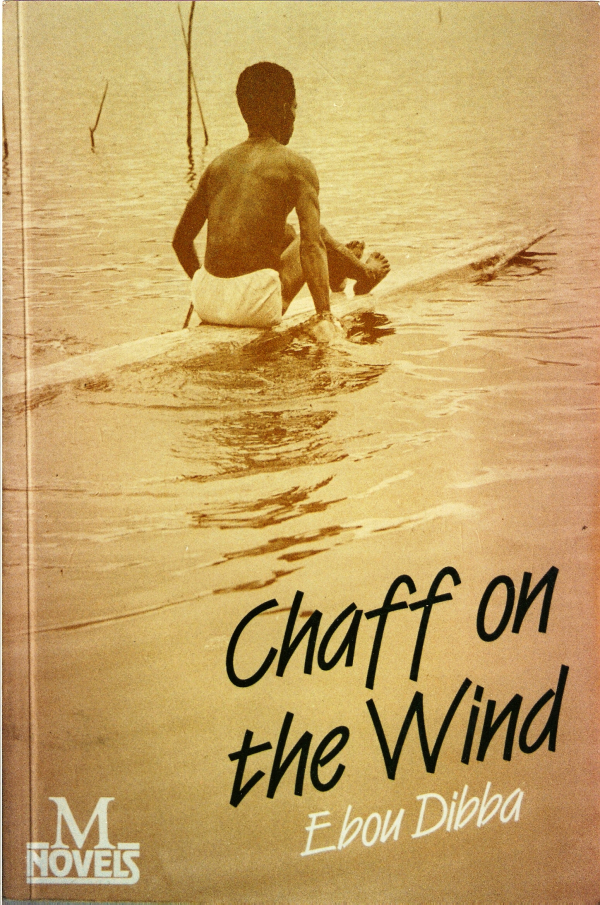
Chaff on the Wind - 1986
Chaff on the Wind is Ebou Dibba's second novel, published in 1986 by Macmillan Education (203 pages divided into 13 chapters). Chaff on the Wind: of the bale on the wind. The 'chaff' is the light plant cover that surrounds each grain of wheat or rice and which is so light that once separated from its support, the slightest breath carries it away. So it is with people caught up in the whirlwind of life. So it is with the novel's two heroes, Pateh the bold and Dinding the timid and naive. Fate seems to have laid out a clear path for them: for the first, success; for the second, a humble and difficult life. It will not be the case, and the opposite will happen.
In the 1930s, Dinding leaves his village in the country's far east. On the boat to the capital, he met Pateh, who became his friend. Pateh immediately finds work in the city and meets a 16-year-old girl, Isatou, whom he falls in love with. But Isatou is proposed by Charles, a 65-year-old bachelor of mixed Portuguese descent and a public writer. "Charles' cousin, the Madame, who is Isatou's boss, opposes this marriage, which she considers inappropriate because of the difference in age and culture. Despite this, Charles becomes a Muslim and marries Isatou, but the wedding turns into a fiasco because Charles is impotent. Isatou becomes pregnant ...with Pateh, who flees with her to Kaolack, where she gives birth to a boy”.
Dinding, for his part, finds work with Jobarteh, a rich Jola trader. Jobarteh takes a liking to him, and as time goes by, he decides to give him his daughter Sira in marriage. Dinding, who had feelings for Kombeh (Isatou's friend), finally agrees. Shortly after the wedding, Jobarteh dies, and Dinding inherits his father-in-law's business.
Now rich, Dinding involves Pateh in his business activities. They meet again in Dakar, but Dinding is frightened by Pateh's morals, who sees a white prostitute. Pateh is imprisoned by the French police, who accuse him of illicit trafficking.
Against a backdrop of colonial events (description of a Prussian plane that lands in Jeshwang and catches fire on take-off; George VI's birthday celebrations in May 1937) and world events (the approach of the Second World War), the author is able to portray the psychological evolution of his two heroes with great accuracy and gives us an interesting picture of the Métis, Signare milieu of the time.
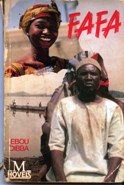
Fafa - 1989
In 1989, three years after his first novel, Chaff on the Wind, Ebou Dibba published his third novel, Fafa, with MacMillan Educational Ltd. Although there is a link between the two texts, as many of the characters in Fafa are already known to the reader, this is not a sequel to the first novel. Therefore, it is not necessary to have read the first novel to understand the second. Fafa (118 pages, divided into 13 chapters) is about a group of four friends: Sidi Masood, a shopkeeper of Moroccan origin; "Guerre Quatorze", who claims to have fought in the First World War (his real name is Paterson and he comes from the Bahamas); "Professeur", a man about town, who is a genuine teacher, (he studied at university in Germany but, during the Second World War, in Burma, he suffered such a shock that he can no longer do his job); and, finally, Fafa, the only real child of the country, employed by Sidi Masood, to look after his shop. The author shows us his four men with different backgrounds and experiences, united by a common friendship. Each is valued by the others because of his difference. The 'professor', for example, carries two books around with him, which he never stops quoting at all times. Sidi Masood likes black American music. "Guerre Quatorze' always has a few anecdotes to tell. As for Fafa, he looks at people and things with an innocent and naive eye.
At the beginning of the novel, we learn that our friends want to solve Fafa's torment: he is in love with the pretty Kombeh and wants to marry her. So what is the problem? It is twofold. On the one hand, Fafa's financial situation is not very encouraging; on the other hand, Kombeh, if she is indeed a child of the provinces like Fafa, was raised by "Madame", a signar. With Marie Pereira, the niece of "Madame", Kombeh was thus given a behaviour style quite different from the traditional one. The shy Fafa let Kombeh know that he was in love and wanted to marry her, but this was not enough to convince her. Unexpectedly, the arrival of Sidi Masood's aunt, who wants to marry her nephew to one of her Moroccan cousins, will precipitate the matter and make it possible to solve Fafa's problem. Indeed, Sidi Masood, who does not want to marry his cousin, devises a stratagem to make people believe he is already married. The aunt is not fooled, and before leaving, she too devises a ploy to "punish" Sidi Masood and help Fafa solve her problem.
If the plot and its happy ending amuse the reader, Ebou Dibba's undeniable art lies in the way he paints the different socio-cultural environments and their impact on individual behaviour.
Alhagie - 1992
Even if they do not write primarily for readers but for themselves, writers need to be read and recognised by an audience. However, just as writers differ in their social background, ideas and mode of expression, so do the audiences they target and reach. At present, an important audience engages with reading but knows little or nothing about itself in books: young students. In The Gambia, as elsewhere in Africa, the written word is gaining ground mainly through schools, and if we look at the growth in the school population over the last ten years, we see that enrolment has more than doubled. For these young people, books are being produced that are better and better adapted to the Gambian reality. Still, books are also needed that can both help them in their practice of the language of instruction (English in this case) and promise to identify and recognise themselves as young Gambians. This is what Ebou Dibba has achieved with Alhaji, which has become the first Gambian book for young people to be included in the Gambian school curriculum.
In the Trendsetters series for teenagers, Alhaji (72 pages) was published in 1992 by Macmillan. The young hero, Alhaji, speaks in the first person and tells the story that has just happened to him. He is 16 years old, lives near Cape Point and attends a high school in Banjul. His life was transformed the day a Swede gave him a horse as a gift, named Alhaji after his young master.
While he was walking to school one day, a beautiful car stopped, and the owner, Kebba, offered to take him to his destination. This meeting is not a coincidence because Kebba has already noticed the young boy and his horse on the beach. This man, who seems to be very rich, invites Alhaji to his hotel, where he even offers him the charms of a young girl. Why so many solicitations? Because Kebba has a plan in which the horse plays a key role. He wants the boy to sell or lend him his horse. The boy refuses. He remembers Kebba's argument with his passenger about a certain 'thing'; he is confronted with an inspector from Sierra Leone who is keeping an eye on Kebba. Even his maths teacher, Quasi, seems to be involved in this surveillance. When the horse disappears, along with Kebba, a chase begins that ends in Senegal. Alhaji discovers that his horse has been used to transport diamonds hidden between the animal's hooves and shoes.


